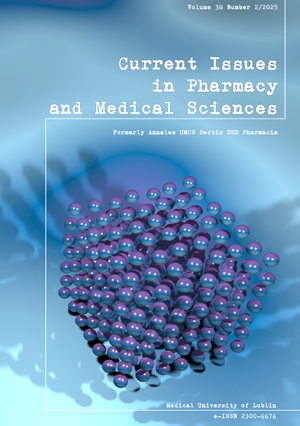Pharmacological properties of natural opioids, their toxicity and dangers of use
DOI:
https://doi.org/10.12923/cipms-2025-0014Keywords:
opioids, toxicity, codeine, morphine, noscapine, papaverineAbstract
Despite their effectiveness as analgesics, antitussives, antispasmodics and constipation drugs, opioids possess many side effects. Moreover, their easy availability contributes to the problem of addiction. In the following review, we focused on the toxicity and side effects of the four most common opioids – morphine, Codeine, Noscapine and Papaverine – to provide reliable information for students, doctors and pharmacists. Their pharmacological effects, as well as side effects have been described.
References
1. Vearrier D, Grundmann O. Clinical pharmacology, toxicity, and abuse potential of opioids. J Clin Pharmacol. 2021;61:70-88.
2. Baldo BA. Toxicities of opioid analgesics: respiratory depression, histamine release, hemodynamic changes, hypersensitivity, serotonin toxicity. Arch Toxicol. 2021;95(8):2627-42.
3. Pacifici GM. Metabolism and pharmacokinetics of morphine in neonates: A review. Clinics (Sao Paulo). 2016;71(8):474-80.
4. Sverrisdóttir E, Lund TM, Olesen AE, Drewes AM, Christrup LL, Kreilgaard M. A review of morphine and morphine-6-glucuronide's pharmacokinetic-pharmacodynamic relationships in experimental and clinical pain. Eur J Pharm Sci. 2015;74:45-62.
5. Zaporowska-Stachowiak I, Oduah MTA, Celichowska M, Dziuba G, Mikolajczak A, Perlińska M, et al. Opioidy w praktyce klinicznej. Varia Medica. 2020;4(1):43-51.
6. Chau N, Elliot DJ, Lewis BC, Burns K, Johnston MR, Mackenzie PI, et al. Morphine glucuronidation and glucosidation represent complementary metabolic pathways that are both catalyzed by UDP-glucuronosyl transferase 2B7: kinetic, inhibition, and molecular modeling studies. J Pharm Exp Ther. 2014;349(1):126-37.
7. Singu B, Verbeeck RK. Should codeine still be considered a WHO essential medicine? J Pharm Pharm Sci. 2021;24(3):329-35.
8. Wright J, Bond C, Robertson HD, Matheson C. Changes in over-the-counter drug misuse over 20 years: perceptions from Scottish pharmacists. J Public Health (Oxf). 2016;38(4):793-9.
9. Rida PCG, LiVecche D, Ogden A, Zhou J, Aneja R. The noscapine chronicle: a pharmaco‐historic biography of the opiate alkaloid family and its clinical applications. Med Res Rev. 2015;35(5):1072-96.
10. Zhou X, Alambyan V, Ostergard T, Pace J, Kohen M, Manjila S, et al. Prolonged intracisternal papaverine toxicity: Index case description and proposed mechanism of action. World Neurosurg. 2018;109:251-7.
11. Mahmoudian M, Mehrpour M, Benaissa F, Siadatpour Z. A preliminary report on the application of noscapine in the treatment of stroke. Eur J Clin Pharmacol. 2003;59(8-9):579-81.
12. Priyadarshani A, Chuttani K, Mittal G, Bhatnagar A. Radiolabeling, biodistribution and gamma scintigraphy of noscapine hydrochloride in normal and polycystic ovary induced rats. J Ovarian Res. 2010;3:10.
13. Gomes DA, Joubert AM, Visagie MH. The biological relevance of papaverine in cancer cells. Cells. 2022;11(21):3385.
14. Han X, Lamshöft M, Grobe N, Ren X, Fist AJ, Kutchan TM, et al. The biosynthesis of papaverine proceeds via (S)-reticuline. Phytochemistry. 2010;71(11-12):1305-12.
15. Smith WS, Dowd CF, Johnston SC, Ko NU, DeArmond SJ, Dillon WP, et al. Neurotoxicity of intra-arterial papaverine preserved with chlorobutanol used for the treatment of cerebral vasospasm after aneurysmal subarachnoid hemorrhage. Stroke. 2004;35(11):2518-22.
Downloads
Published
Issue
Section
License
Copyright (c) 2025 Authors

This work is licensed under a Creative Commons Attribution-NonCommercial-NoDerivatives 3.0 Unported License.


